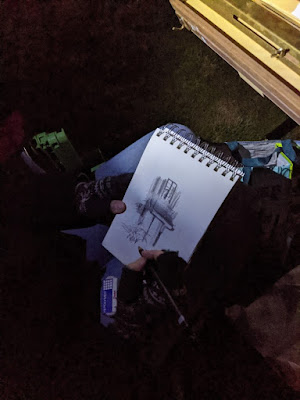Your teacher is important, but the students turn a good workshop into a great one.
 |
| Students painting at Schoodic Point this year. That was the last sun we saw. (All photos courtesy Jennifer Johnson.) |
I’m teaching in Acadia this week, and it’s fog-bound and rainy. But this is a great group—intrepid and interested. They’re learning a lot despite the unseasonable dampness, and I’m having a blast teaching them.
How can you get the most from a workshop or class? Here are some simple suggestions:
Study the supply list.
Note that I didn’t say, “run right out and buy everything on it.” Every teacher has a reason for asking for those materials. In my case, it’s that I teach a system of paired primaries. You can’t understand color theory without the right starting pigments. Another teacher might have beautiful mark-making. If you don’t buy the brushes he suggests, how are you going to understand his technique?
A tube of cadmium green that I once bought for a workshop and never opened still rankles. I never want to do that to one of my students. When you study with me, I want you to read my supply lists. If something confuses you, or you think you already have a similar item, email and ask.
 |
| Paula Tefft working in watercolor. |
Bring the right clothes.
It’s been ranging between the 50s and 80s in Maine this summer. If you come north without a hoodie, you will be chilled in the evenings, but you need shorts and a tee-shirt during the day.
I send my students a packing list for clothes and personal belongings. If you’re going on the Age of Sail, Shary will send you a different list, meant for a boat. Follow these instructions, especially in the matter of insect repellent. I didn’t, because I am seldom bit, but I have whackin’ great blisters on my ankles right now. With all the rain we’ve had, the mosquitoes have been voracious.
Know what you’re getting into.
“How can you stand this? It’s all so green!” an urban painter once said to me after a week in the Adirondacks.
There are no Starbucks in Acadia National Park, in the Pecos National Wilderness, or on the clear, still waters of Penobscot Bay. If you’re dependent on your latte macchiato, you may find it uncomfortable at first. (Somehow, there’s always coffee, even without cell-phone reception.) However, the seals, dolphins and eagles are ample compensation.
 |
| Hayley R. painting in Paradise. |
Be prepared to get down and dirty.
I’m not talking about the outdoors here, I’m talking about change and growth. I am highly competitive myself, so it’s difficult for me to feel like I’m struggling. However, it’s in challenging ourselves that we make progress. Use your teacher’s method while you’re at the workshop, even if you feel like you’ve stepped back ten years in your development. That’s a temporary problem.
You can disregard what you learn when you go home, or incorporate only small pieces into your technique, but you traveled to be challenged, and you can’t do that if you cling to your own technique.
Connect with your classmates
I know painters from all over the US. I met most of them in plein air events. There’s power in those relationships. Exchange email addresses. Keep in contact. Follow them on Instagram or Twitter.
Take good notes.
Listen for new ideas, write down concepts, and above all, ask questions. If your teacher can’t stop and answer them mid-stream, save them for after the demo.































